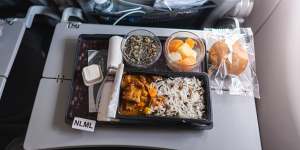Some dishes taste better than others at 30,000 feet. If you’re sawing away at your meat or choking on a dry sandwich,you’ve made the wrong choice.

At 10,000 metres,some dishes taste better than others.Greg Straight
Be aware that low cabin humidity affects your ability to smell,a key contributor to taste. Low cabin pressure also reduces the ability of your taste buds to detect saltiness and sugar. Research conducted by Lufthansa concluded that passengers lose up to 70 per cent of their sense of taste while aloft.
Airlines add extra salt and sugar into the recipes to compensate,as well as (in business class at least) fresh herbs and ingredients such as ginger and garlic that provide taste bombs. You can,however,up the ante by choosing any dish big on umami.
This salty,meaty flavour is found in ingredients such as tomato,cheese,eggs,mushrooms,beans and soy sauce. Umami is more easily detected by your taste buds at altitude,and it enhances the flavour of other ingredients.

Your sense of taste is affected by altitude,so choose your meals accordingly (if you have options).iStock
Next,be aware that airlines rely on pre-packaged,pre-cooked food that is reheated in steam ovens on board. Large cuts of meat,duck breast,seafood and fish tend to overcook and dry out,especially in economy class.
You’re usually better off choosing the vegetarian option,particularly as this is often pasta. Bonus:airlines generally serve it with tomato sauce and mozzarella or parmesan cheese,both big on umami flavours.
Pick a curry or stew (such as beef bourguignon or beef stroganoff) and your meal will seem fresher because these types of dishes reheat well,and most have spices that retain flavour. Any mushiness can be counteracted by a sprinkling of peanuts from the sachet served with your drink.
Other good inflight options are mezze dips such as hummus and babaganoush,and salads of grains such as barley,quinoa and rice. Be warned however that with cold dishes,altitude and chilling enhance bitterness.
Irrespective of these considerations,you should go for the airline’s native cuisine if you have the choice. Nasi lemak on Malaysia Airlines,bento boxes on Japanese planes,curries on Thai Airways and local dishes on Turkish Airlines are generally better than international alternatives.
Light meals are great too:as long as you aren’t too hungry,choose salads,fruit or low-carb options. You’ll often get good flavour – and healthier ingredients – if you request special meals,whether vegetarian,vegan,halal or kosher. Even better,these are delivered first,unlike the slowly congealing standard meals in trolleys.
Bottom line? It also depends on what airline you fly on,as some simply deliver superior inflight food. But that’s for another time.